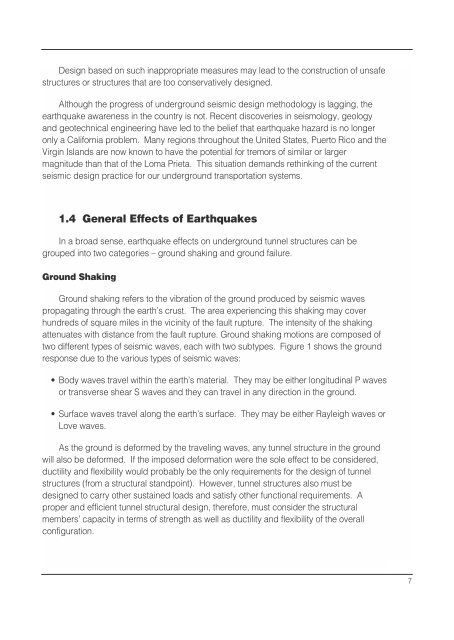Seismic Design of Tunnels - Parsons Brinckerhoff
Seismic Design of Tunnels - Parsons Brinckerhoff
Seismic Design of Tunnels - Parsons Brinckerhoff
You also want an ePaper? Increase the reach of your titles
YUMPU automatically turns print PDFs into web optimized ePapers that Google loves.
<strong>Design</strong> based on such inappropriate measures may lead to the construction <strong>of</strong> unsafe<br />
structures or structures that are too conservatively designed.<br />
Although the progress <strong>of</strong> underground seismic design methodology is lagging, the<br />
earthquake awareness in the country is not. Recent discoveries in seismology, geology<br />
and geotechnical engineering have led to the belief that earthquake hazard is no longer<br />
only a California problem. Many regions throughout the United States, Puerto Rico and the<br />
Virgin Islands are now known to have the potential for tremors <strong>of</strong> similar or larger<br />
magnitude than that <strong>of</strong> the Loma Prieta. This situation demands rethinking <strong>of</strong> the current<br />
seismic design practice for our underground transportation systems.<br />
1.4 General Effects <strong>of</strong> Earthquakes<br />
In a broad sense, earthquake effects on underground tunnel structures can be<br />
grouped into two categories – ground shaking and ground failure.<br />
Ground Shaking<br />
Ground shaking refers to the vibration <strong>of</strong> the ground produced by seismic waves<br />
propagating through the earth’s crust. The area experiencing this shaking may cover<br />
hundreds <strong>of</strong> square miles in the vicinity <strong>of</strong> the fault rupture. The intensity <strong>of</strong> the shaking<br />
attenuates with distance from the fault rupture. Ground shaking motions are composed <strong>of</strong><br />
two different types <strong>of</strong> seismic waves, each with two subtypes. Figure 1 shows the ground<br />
response due to the various types <strong>of</strong> seismic waves:<br />
• Body waves travel within the earth’s material. They may be either longitudinal P waves<br />
or transverse shear S waves and they can travel in any direction in the ground.<br />
• Surface waves travel along the earth’s surface. They may be either Rayleigh waves or<br />
Love waves.<br />
As the ground is deformed by the traveling waves, any tunnel structure in the ground<br />
will also be deformed. If the imposed deformation were the sole effect to be considered,<br />
ductility and flexibility would probably be the only requirements for the design <strong>of</strong> tunnel<br />
structures (from a structural standpoint). However, tunnel structures also must be<br />
designed to carry other sustained loads and satisfy other functional requirements. A<br />
proper and efficient tunnel structural design, therefore, must consider the structural<br />
members’ capacity in terms <strong>of</strong> strength as well as ductility and flexibility <strong>of</strong> the overall<br />
configuration.<br />
7
















